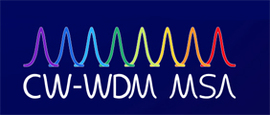 |
Date Announced: 09 Jun 2021
Specification facilitates advances in artificial intelligence, data center efficiency, and other advanced applications of optical interconnect.
SANTA CLARA, Calif., USA – The CW-WDM MSA (Continuous-Wave Wavelength Division Multiplexing Multi-Source Agreement) Group, dedicated to defining and promoting specifications for multi-wavelength advanced integrated optics, today announced the release of its first official specification for 8, 16, and 32 wavelength optical sources.
The Multi-Source Agreement (MSA) defines laser sources covering three spans in the O-band wavelength grids. These lasers can be used as optical sources for multiple applications such as high- density co-packaged optics, machine learning, and optical computing. Each wavelength grid is defined with enough technical detail to ensure interoperability across the range of applications. The MSA also outlines measurement methods required for standards compliance.
“The CW-WDM MSA just published an 8, 16, and 32 wavelength O-band laser source standard for use in optical transceivers for emerging advanced datacom applications,” commented Chris Cole, Chair of the MSA. “Laser sources are the critical component in optical communications and having an agreed set of grids creates great opportunities for transceiver and laser suppliers to develop innovative products.”
Key Highlights of the MSA Specifications:
Frequency assignments for 8, 16 and 32 wavelength grid configurations with multiple grid spacings
Two physical configurations, including a modular optical source with each output port carrying a single wavelength, and an integrated optical source with each output port carrying all the wavelengths
A range of output power classes targeting applications that require very low and very high output levels
Definitions of optical parameters and measurement methods, including relative intensity noise, side mode suppression ratio (SMSR), and linewidth
Fixed and flexible wavelength grid configurations to support deployment in a variety of environmental conditions
About the CW-WDM MSA
The CW-WDM MSA (Continuous-Wave Wavelength Division Multiplexing Multi-Source Agreement) was formed to standardize WDM CW sources in the O-band for emerging advanced integrated optics applications that are expected to move to 8, 16, and 32 wavelengths. Such higher wavelength counts are needed for emerging applications such as silicon photonics (SiPh) based high-density co-packaged optics, optical computing, and AI, and enable a leap in performance, efficiency, cost, and bandwidth scaling compared with previous technology generations.
Promoter Members of the CW-WDM MSA are Arista Networks, Ayar Labs, II-VI Incorporated, imec, Intel Corporation, Lumentum, Luminous Computing, MACOM, Quintessent, Sivers Photonics, and Sumitomo Electric.
For a list of Observer Members and more information about the CW-WDM MSA, please visit https://cw- wdm.org
E-mail: https://cw-wdm.org/#contact
Web Site: https://cw-wdm.org
| © 2026 SPIE Europe |
|